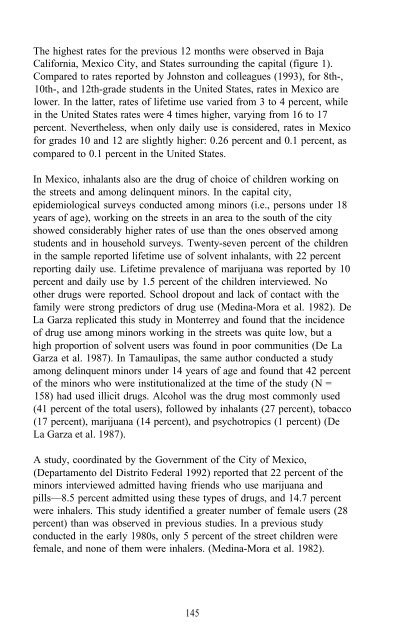Epidemiology of Inhalant Abuse - Archives - National Institute on ...
Epidemiology of Inhalant Abuse - Archives - National Institute on ...
Epidemiology of Inhalant Abuse - Archives - National Institute on ...
Create successful ePaper yourself
Turn your PDF publications into a flip-book with our unique Google optimized e-Paper software.
The highest rates for the previous 12 m<strong>on</strong>ths were observed in Baja<br />
California, Mexico City, and States surrounding the capital (figure 1).<br />
Compared to rates reported by Johnst<strong>on</strong> and colleagues (1993), for 8th-,<br />
10th-, and 12th-grade students in the United States, rates in Mexico are<br />
lower. In the latter, rates <str<strong>on</strong>g>of</str<strong>on</strong>g> lifetime use varied from 3 to 4 percent, while<br />
in the United States rates were 4 times higher, varying from 16 to 17<br />
percent. Nevertheless, when <strong>on</strong>ly daily use is c<strong>on</strong>sidered, rates in Mexico<br />
for grades 10 and 12 are slightly higher: 0.26 percent and 0.1 percent, as<br />
compared to 0.1 percent in the United States.<br />
In Mexico, inhalants also are the drug <str<strong>on</strong>g>of</str<strong>on</strong>g> choice <str<strong>on</strong>g>of</str<strong>on</strong>g> children working <strong>on</strong><br />
the streets and am<strong>on</strong>g delinquent minors. In the capital city,<br />
epidemiological surveys c<strong>on</strong>ducted am<strong>on</strong>g minors (i.e., pers<strong>on</strong>s under 18<br />
years <str<strong>on</strong>g>of</str<strong>on</strong>g> age), working <strong>on</strong> the streets in an area to the south <str<strong>on</strong>g>of</str<strong>on</strong>g> the city<br />
showed c<strong>on</strong>siderably higher rates <str<strong>on</strong>g>of</str<strong>on</strong>g> use than the <strong>on</strong>es observed am<strong>on</strong>g<br />
students and in household surveys. Twenty-seven percent <str<strong>on</strong>g>of</str<strong>on</strong>g> the children<br />
in the sample reported lifetime use <str<strong>on</strong>g>of</str<strong>on</strong>g> solvent inhalants, with 22 percent<br />
reporting daily use. Lifetime prevalence <str<strong>on</strong>g>of</str<strong>on</strong>g> marijuana was reported by 10<br />
percent and daily use by 1.5 percent <str<strong>on</strong>g>of</str<strong>on</strong>g> the children interviewed. No<br />
other drugs were reported. School dropout and lack <str<strong>on</strong>g>of</str<strong>on</strong>g> c<strong>on</strong>tact with the<br />
family were str<strong>on</strong>g predictors <str<strong>on</strong>g>of</str<strong>on</strong>g> drug use (Medina-Mora et al. 1982). De<br />
La Garza replicated this study in M<strong>on</strong>terrey and found that the incidence<br />
<str<strong>on</strong>g>of</str<strong>on</strong>g> drug use am<strong>on</strong>g minors working in the streets was quite low, but a<br />
high proporti<strong>on</strong> <str<strong>on</strong>g>of</str<strong>on</strong>g> solvent users was found in poor communities (De La<br />
Garza et al. 1987). In Tamaulipas, the same author c<strong>on</strong>ducted a study<br />
am<strong>on</strong>g delinquent minors under 14 years <str<strong>on</strong>g>of</str<strong>on</strong>g> age and found that 42 percent<br />
<str<strong>on</strong>g>of</str<strong>on</strong>g> the minors who were instituti<strong>on</strong>alized at the time <str<strong>on</strong>g>of</str<strong>on</strong>g> the study (N =<br />
158) had used illicit drugs. Alcohol was the drug most comm<strong>on</strong>ly used<br />
(41 percent <str<strong>on</strong>g>of</str<strong>on</strong>g> the total users), followed by inhalants (27 percent), tobacco<br />
(17 percent), marijuana (14 percent), and psychotropics (1 percent) (De<br />
La Garza et al. 1987).<br />
A study, coordinated by the Government <str<strong>on</strong>g>of</str<strong>on</strong>g> the City <str<strong>on</strong>g>of</str<strong>on</strong>g> Mexico,<br />
(Departamento del Distrito Federal 1992) reported that 22 percent <str<strong>on</strong>g>of</str<strong>on</strong>g> the<br />
minors interviewed admitted having friends who use marijuana and<br />
pills—8.5 percent admitted using these types <str<strong>on</strong>g>of</str<strong>on</strong>g> drugs, and 14.7 percent<br />
were inhalers. This study identified a greater number <str<strong>on</strong>g>of</str<strong>on</strong>g> female users (28<br />
percent) than was observed in previous studies. In a previous study<br />
c<strong>on</strong>ducted in the early 1980s, <strong>on</strong>ly 5 percent <str<strong>on</strong>g>of</str<strong>on</strong>g> the street children were<br />
female, and n<strong>on</strong>e <str<strong>on</strong>g>of</str<strong>on</strong>g> them were inhalers. (Medina-Mora et al. 1982).<br />
145
















